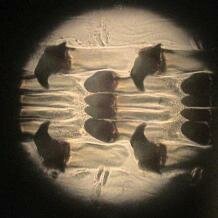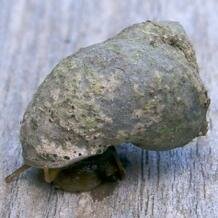Topic: Agriculture in aquatic snails
Termites and ants are famous for tending fungal gardens, but did you know that also a marine snail farms a fungus? And this is not the only example of agriculture in this group…
 The radula, the molluscan rasping organ located in the foregut, is an important prerequisite for the evolution of agriculture in marine snails. It seems that the “farming” of microorganisms has evolved a number of times in this group, mainly involving algae or bacteria, but in one case an ascomycete fungus!
The radula, the molluscan rasping organ located in the foregut, is an important prerequisite for the evolution of agriculture in marine snails. It seems that the “farming” of microorganisms has evolved a number of times in this group, mainly involving algae or bacteria, but in one case an ascomycete fungus!
Fungal farming
Perhaps the most remarkable example of farming by a snail is found in the North American marsh periwinkle (Littoraria irrorata), because this is the only mollusc to farm fungi.  Fungal cultivation is, of course, the hallmark of the insects, where it is practised by ants, termites and beetles. In the case of this littorinid, it wounds salt marsh cordgrass (Spartina alterniflora) with its radula, which leads to the plant tissue being invaded by an ascomycete fungus. The snail enhances fungal growth by fertilising the wounds with its faecal pellets, which are rich in nitrogen, and fungus hyphae (as the snail digests only half of the mycelium it consumes). In contrast to ants and termites, the molluscs do not seem to inoculate the plant tissue or weed their crops (which is not necessary if the fungi occur naturally and are resistant against pathogens and competitors). The relationship is evidently an obligate mutualism – the fungus gains easy access to the plant tissue, while the snail feeds on it. Laboratory studies showed that the periwinkles cannot thrive on sterile marsh grass leaves or ones with bacterial growth. This mutualism, however, is highly detrimental to the host plant, as snail and fungus activity can reduce plant growth by 40-100%.
Fungal cultivation is, of course, the hallmark of the insects, where it is practised by ants, termites and beetles. In the case of this littorinid, it wounds salt marsh cordgrass (Spartina alterniflora) with its radula, which leads to the plant tissue being invaded by an ascomycete fungus. The snail enhances fungal growth by fertilising the wounds with its faecal pellets, which are rich in nitrogen, and fungus hyphae (as the snail digests only half of the mycelium it consumes). In contrast to ants and termites, the molluscs do not seem to inoculate the plant tissue or weed their crops (which is not necessary if the fungi occur naturally and are resistant against pathogens and competitors). The relationship is evidently an obligate mutualism – the fungus gains easy access to the plant tissue, while the snail feeds on it. Laboratory studies showed that the periwinkles cannot thrive on sterile marsh grass leaves or ones with bacterial growth. This mutualism, however, is highly detrimental to the host plant, as snail and fungus activity can reduce plant growth by 40-100%.
Microorganismal growth on mucous trails
A more primitive form of snail agriculture is observed in various aquatic species that leave behind them a mucous trail, which is secreted to assist locomotion. These snails have limited home ranges and retrace their own mucous trails, which have persisted long enough to trap microalgae (mainly diatoms) and bacteria. In some species (e.g. the true limpet Collisella scabra), the mucus was shown to stimulate growth of the microorganisms (with bacterial growth occurring first and potentially promoting algal growth). Grazing this nutritious food source might offset the high metabolic costs of producing the mucus in the first place. Such behaviour is not limited to marine snails but is also found in some freshwater species (e.g. the pulmonate Planorbis contortus) and brackish water species (e.g. the prosobranch Hydrobia ventrosa), where the mucous trails enhance the growth of bacteria that are ingested preferentially by the snails.
Algal gardening
 A number of true limpets (Patellogastropoda) have evolved mutualisms with algae. These marine gastropods live in the intertidal zone, where they are important members of the community. All limpet gardeners are relatively large in size (with the exception of the considerably smaller Scutellastra flexuosa) and territorial, defending a food supply against competitors. They can be divided into periphery gardeners and patch gardeners. The former tend a garden of filamentous red algae growing on a substrate of coralline algae around the margins of their shell, whereas the latter convert a larger area into an algal farm, which they then graze. The two groups also differ in their shell morphology, with patch gardeners having more rounded shell profiles, while in periphery gardeners the front of the shell is extended and has an angular profile.
A number of true limpets (Patellogastropoda) have evolved mutualisms with algae. These marine gastropods live in the intertidal zone, where they are important members of the community. All limpet gardeners are relatively large in size (with the exception of the considerably smaller Scutellastra flexuosa) and territorial, defending a food supply against competitors. They can be divided into periphery gardeners and patch gardeners. The former tend a garden of filamentous red algae growing on a substrate of coralline algae around the margins of their shell, whereas the latter convert a larger area into an algal farm, which they then graze. The two groups also differ in their shell morphology, with patch gardeners having more rounded shell profiles, while in periphery gardeners the front of the shell is extended and has an angular profile.
Pear limpet (Scutellastra cochlear)
This South African species, which forms dense populations on wave-exposed shores  and constitutes the ‘cochlear zone’, is an example of a periphery gardener. Each limpet is surrounded by a small garden of rhodophytes (e.g. Herposiphonia heringii or Gelidium micropterum), which it grazes regularly, in addition to feeding on encrusting corallines in the vicinity. The algae have a high organic content and a low C:N ratio, which is thought to increase their food value and indicate high productivity. Pear limpets enhance the productivity of their algal gardens through regular cropping and nitrogenous excretions. In the short periods of the tidal cycle during which the limpet is exposed, ammonium and urea accumulate under its shell and thus become available for uptake by the algae. Experiments showed that the average amount of ammonium a limpet excretes meets the algae’s nitrogen growth requirements. As the algae are able to take up nitrogen at an elevated rate (‘surge’ uptake), they can make use of nitrogenous excretions before these are dissipated by water movement. This fertilisation obviously increases the primary production available for ingestion by the snail, and both partners benefit from their intimate association. When limpets were removed from their gardens, these were quickly overgrown by other algae.
and constitutes the ‘cochlear zone’, is an example of a periphery gardener. Each limpet is surrounded by a small garden of rhodophytes (e.g. Herposiphonia heringii or Gelidium micropterum), which it grazes regularly, in addition to feeding on encrusting corallines in the vicinity. The algae have a high organic content and a low C:N ratio, which is thought to increase their food value and indicate high productivity. Pear limpets enhance the productivity of their algal gardens through regular cropping and nitrogenous excretions. In the short periods of the tidal cycle during which the limpet is exposed, ammonium and urea accumulate under its shell and thus become available for uptake by the algae. Experiments showed that the average amount of ammonium a limpet excretes meets the algae’s nitrogen growth requirements. As the algae are able to take up nitrogen at an elevated rate (‘surge’ uptake), they can make use of nitrogenous excretions before these are dissipated by water movement. This fertilisation obviously increases the primary production available for ingestion by the snail, and both partners benefit from their intimate association. When limpets were removed from their gardens, these were quickly overgrown by other algae.
Duck’s foot limpet (Scutellastra longicosta)
 This patch gardener shows a non-obligate mutualism with the crustose brown alga Ralfsia verrucosa. Also here, the presence of the limpet increases the alga’s photosynthetic rate (by about 30%). This seems to be a response to grazing rather than being due to nutrient regeneration by the limpet. By cutting regular paths across the alga’s crust, the limpet creates numerous edges, where the alga can quickly re-grow. As these secondary growth sites are younger tissues, they show higher photosynthetic activity (and are easier to digest as well). The limpets benefit from higher productivity as this allows them to maintain smaller gardens, which are easier to defend against destructive grazers. The limpets also remove algal competitors – crustose algae are quickly overgrown due to their relatively slow growth rate. Thus, the alga benefits from the association with the snail and is found mainly (but not exclusively) in snail territories.
This patch gardener shows a non-obligate mutualism with the crustose brown alga Ralfsia verrucosa. Also here, the presence of the limpet increases the alga’s photosynthetic rate (by about 30%). This seems to be a response to grazing rather than being due to nutrient regeneration by the limpet. By cutting regular paths across the alga’s crust, the limpet creates numerous edges, where the alga can quickly re-grow. As these secondary growth sites are younger tissues, they show higher photosynthetic activity (and are easier to digest as well). The limpets benefit from higher productivity as this allows them to maintain smaller gardens, which are easier to defend against destructive grazers. The limpets also remove algal competitors – crustose algae are quickly overgrown due to their relatively slow growth rate. Thus, the alga benefits from the association with the snail and is found mainly (but not exclusively) in snail territories.
Cite this web page
Map of Life - "Agriculture in aquatic snails"
https://mapoflife.org/topics/topic_467_agriculture-in-aquatic-snails/
August 4, 2017

